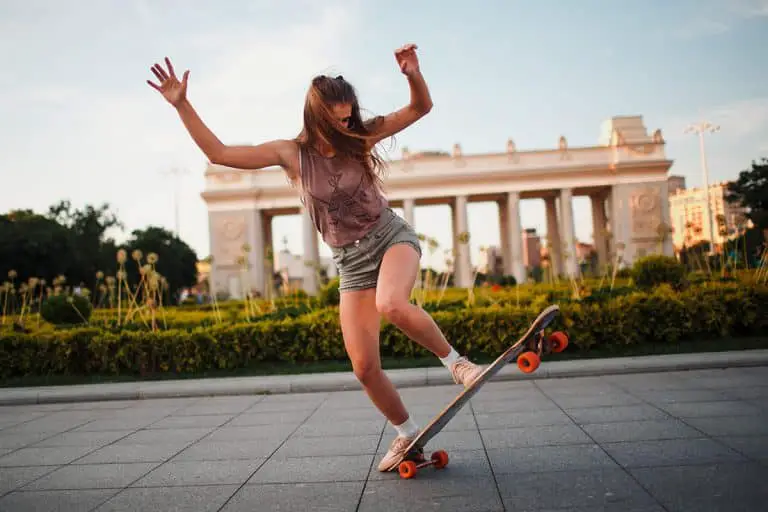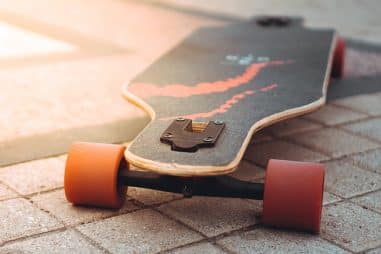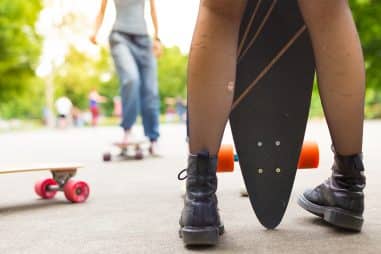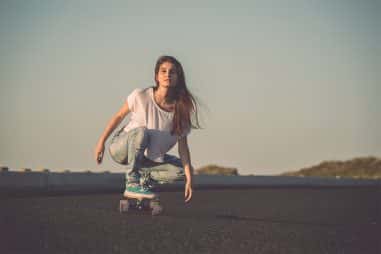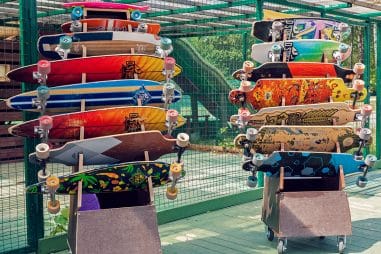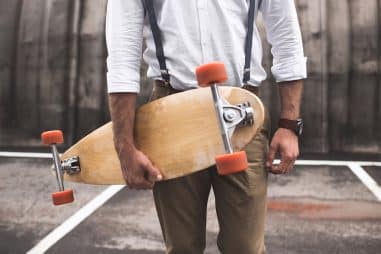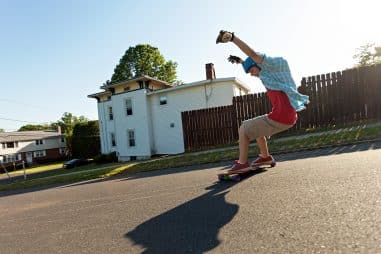It is very advantageous to learn both carving and dancing as they will certainly come in handy in your longboarding journey eventually. They are both extremely beautiful, stylish, and artistic riding styles. Apart from that, both carving and dancing are also amazing ways to improve your longboarding skills such as balance, coordination, flexibility, reflex, reaction time, and many more while you ride on the road with grace.
Can You Carve on a Longboard?
It is possible to carve on a longboard. In fact, it is an essential part of the sport, and learning how to do it will be very beneficial. Carving gives you more control over your board which allows you to slow down.
Carving is not a new technique. As a matter of fact, it is a very popular technique that has been done on skateboards and snowboards. However, longboarding takes carving to the next level because longboards are exceptionally great for carving, and learning how to do this fun technique will surely give you a unique riding experience.
What Does Carving Mean in Longboarding?
Carving in longboarding means carrying out fast wide or sharp turns one after the other on your longboard as you follow an S shape pattern. It is a very effective way to slow your board down and it will be of great use if you lose control of your longboarding speed .
It might take you quite a while to learn carving especially if you’re a beginner, but it will be a really fun thing to do once you understand how to do it. There is no rush so spend time having fun and practicing as much as you can and give yourself time to learn this very useful skill.
What Is the Point of Carving on a Longboard?
Carving helps you keep your speed in check. It is extremely easy to lose control of your speed when longboarding which is why learning how to carve is very useful. If you ever end up going too fast, carving is an amazing way to help slow you down.
Additionally, it lets you travel long distances without exerting too much effort pushing by performing carves and pumps. Carving can be a little technical yet creative at the same time as it provides you with almost the same wonderful sensation when you ride the waves in the ocean. Again, the beautiful feeling that carving has to offer will give you a one-of-a-kind longboarding experience.
What Is the Difference Between Cruising and Carving on a Longboard?
Cruising is usually done by going around places as you push on a longboard. It is also often referred to as using your longboard as a means of transportation. On the other hand, carving is a riding style that is done by performing quick consecutive turns to help you control the speed of your board.
It is important to know the difference between the two especially when you’re choosing which board to get. This will greatly help you in deciding which one to get so figure out what you plan to use your board for ahead of time. There are longboards made for both cruising and carving and they each have their own uses.
What Type of Longboard Is Best for Carving?
The best longboards for carving are top-mount boards particularly the ones that are made for commuting and traveling long distances. Drop-through boards also do a great job especially in performing swift carving.
There are a couple of factors that you need to account for to make the most out of your carving experience such as the deck and the trucks. You can choose from a lot of carving boards that are available in the market, but you might want to take a look at these longboards:
- Fish: Many call this board “The Porsche of Longboards” and every longboarder would love to get their hands on this board. Its very light trucks are designed for extreme carving which makes it insanely fast and powerful. This board’s speed and power are unparalleled which allows you to turn rail-to-rail remarkably.
- Loaded Vanguard: flex of this longboard is very springy that some would even say it’s very much like a trampoline. Since the wheels are mounted at the very ends of the deck, it gives you the ability to perform deep carves efficiently that you usually won’t be able to do on other boards
- Loaded Icarus: A combination of bamboo and fiberglass is used to build this board. From sourcing of the materials to the engineering itself, it takes a lot to construct a board this extraordinary. It is an advanced, top of the line, and high-quality board particularly made for carving, so it does not come at a cheap price but there is nothing to worry about because your money will not go to waste and you will really get what you paid for.
- Chamber Longboard: This board has Gullwing trucks which makes it a really great board for carving. Moreover, its price is relatively cheap compared to other carving boards. You can get one for a very affordable price of less than $200.
- Arbors Zeppelin: The material used in making the Arbors Zeppelin is bamboo thereby giving it the capability to flex outstandingly when turning. This board is short and incredibly light which makes it very easy for you to carry it around anywhere. It’s a great board for traveling from one place to another while having lots of fun carving.
Also, the flexibility of the deck has a great impact on pumping and carving. Ideally, the best deck materials are bamboos and maples. Fiberglass does a great job as well but once you have experienced riding on both you will observe that bamboos have way better flexibility.
Is Longboard Dancing Hard?
It might be a little hard in the beginning and it might also take you quite some time before you learn how to dance on your longboard. The first thing you need to do is to feel comfortable whenever you ride your board. You must feel secure on your board if you want to start longboard dancing because you will be moving your feet and your whole body around in slightly unusual ways.
With that said, it is a known fact that if you want to become ultimately good at something then you have to invest lots and lots of time and effort. Spend hours and hours practicing and you will learn how to do it eventually. After all, nothing ever really comes easy.
Who Invented Longboard Dancing?
It is not really certain who invented longboarding dancing, but Adam Colton and Adam Stokowski were the very first ones that started dancing on longboards and they played a very big role in influencing other people to start doing it too. The two skaters began to mix fluid footwork and tricks in the way they ride back in the early 2000s. Adam Stokowski leaned towards freestyling where he carried out balance-based tricks and traditional flip tricks without any difficulty.
On the other side, Adam Colton was really outstanding at longboard dancing because of his insanely rapid movements and extremely polished steps combined with his exceptional sense of balance. You would think that it is not that great of a feat and that is what most skaters think as well but not until they learn that he was working with a board that was longer than 50 inches and he was moving it around as if it were the easiest thing to do. They both had a great relationship with the board they were riding on which enabled them to dance on longboards effortlessly.
What Kind of Longboard Should I Get for Dancing?
You can dance on any type of longboard as long as you have enough balance but nearly all the best dancing longboards usually have a double kicktail. This gives you the ability to pop the board with ease and perform different tricks such as manuals and nose manuals. Longboards that are not too heavy are also a good option for dancing boards because it is much easier to control them.
It is also much better if they have a softer flex to them but not too soft that you might fall off your board if you move around. Just the right amount of softness will be enough to let you play around and experiment with the flexibility. Here are a few choices that you might want to check out if you want to try dancing on your longboard:
- Loaded Bhangra
- Loaded Tarab
- ENKEEO 40 Inch Drop Through Longboard
- Legend X-Flex
- BC Plankton
- Bustin Daensu
- DINBIN Drop Through 8 Ply Maple Longboard
- LBL OSD (Long Board Larry Old School Dancer)
- Magneto Mini Cruiser Skateboard
- Magneto Bamboo Dancer
- Hana 42 Inch Longboard
- Landyatchz Stratus
- AM Wood 1/2 Dance
- Rayne Whip
- Playshion Drop Through Longboard
Can You Dance on a Freestyle Longboard?
As mentioned earlier, it is possible to dance on any type of longboard, a freestyle longboard included. You just need to have a good sense of balance, so you won’t fall off your board and end up harming yourself.
There is no problem at all if you want to do some dancing on a freestyle longboard, but you must remember that there are boards specifically made for longboard dancing. These boards will help you dance on longboards much more easily since they were thoroughly thought of and constructed for that exact purpose.
What Size Longboard Should I Get for Dancing?
The deck for longboard dancing should at least be 110cm long. If you gravitate towards freestyling (performing shuvits, ollies, no-complies), then a shorter board is perfect for you because it weighs less and it will allow you to perform flips and tricks. On the other hand, if you want to dance, a longer deck suits you best because it will provide you with a much bigger space where you can move around and dance.
Boards particularly made for dancing are slightly longer than other setups (cruiser, downhill, freestyle, or freeride). A longer board means that you have more room for your feet. This allows you to have a wider platform to move on and it also lets you maneuver your board with a lot less difficulty.
How Do I Choose a Longboard for Dancing?
You must know what kind of longboarding you want to do. There is a wide variety of riding styles to choose from so having an idea of the riding style you want to do will help you narrow down the choices. Not to mention, it will also have a great impact on your board setup.
Now that you have an idea of what you plan to use your board for, the next step is to go to a skate shop and select your board. Keep in mind that being picky about the skate shop you want to buy your board from is completely fine. Make sure to talk and ask for assistance from the staff. They can even give you advice if you need it.
What Is Free Riding on a Longboard?
Freeriding is one of the most well-known styles of longboarding. It is done by riding down a hill but at slower speeds. Centered on doing artistic power slides, the rider goes down a hill while controlling his/her descent.
As its name implies, the rider is free to do whatever he/she wants while going down a hill. It is different from downhill racing because it is a lot less intense and more focused on performing techniques such as slides, technical slides, spins, early grabs, flip tricks, tail whips, manuals, and a lot more rather than reaching speeds of more than 60 miles per hour.
How Do You Freeride a Longboard?
You will need to learn the essential skill of riding switch, the opposite of your natural riding stance, to freeride a longboard. If you ride your longboard with your left foot forward, you must also learn how to ride your longboard with your right foot forward and vice versa. Your level of comfortability in riding both stances will greatly help you in performing much more advanced slides.
Depending on your personal preference and level of skill, you can choose if you want your freeride longboards to be flexible or stiff. If you want to start freeriding on a longboard, it is important that you wear protective gear to avoid wounding yourself especially if you’re new to the sport. With that said, here’s a guide to help you learn freeriding on a longboard:
- Get comfortable: You can start learning how to push, stop, and slow your board down in an area where only a few cars pass by. It’s even better if there are no cars at all. Once you’re comfortable pushing around and carving, it will be much easier for you to learn how to freeride.
- Practice going down on small hills with a few carves: Locate a corner where you can turn. If you turn faster and put a lot more weight on your gloved hands as they touch the ground, it will be much easier for you to slide.
- Learn how to slide: Once you learn how to slide down skillfully on small hills both toe side and heel side, you can begin riding on more challenging roads with a lot more corners. Bear in mind to always practice responsibly and prioritize putting your safety first at all times.
What Is a Freestyle Longboard?
A freestyle longboard is used in freestyle longboarding, a very technical style of riding, wherein the rider performs different continuous stunts by flipping their board and other tricks. This type of board is usually ridden on flat surfaces and occasionally uses the obstacles (curbs and stairways) around the area.
Most of the time, freestyle longboards are used by riders who want to get into technical sliding on bigger boards but have no intention to start riding longboards that have deep concaves such as drop-down or drop-through longboards. However, there are also a good number of riders that want to ride on full-sized freestyle longboards so they can begin to ride ramps or bowls at the skatepark and perform kickflips.
What Is Pumping on a Longboard?
Most riders begin by pushing to get their board going. Pumping is originally a technique used by skateboarders to accelerate without having the rider’s feet off the board. In longboarding, it is more commonly known as Long-Distance Pumping (LDP).
Pumping is another way to propel yourself while riding your longboard. Pumping is quite similar to carving, but it is used to increase speed whereas carving is used to reduce speed. It is done by performing consecutive “S” turns by shifting your weight left and right a lot faster as you would when carving.
How Do You Pump a Longboard?
A lot of longboarders say that pumping is best learned when you see it through your eyes. Observe and keep in mind how other longboarders do it then try to imitate the same motions you have seen. However, if you prefer to read about it, here’s a step-by-step guide to help you understand how to pump a longboard:
- To start pumping your longboard, give it a little push to acquire a bit of initial momentum.
- Afterward, apply a lot of pressure on the rail using your front foot to turn the board.
- With the use of your back foot, make your trucks turn by pushing back sideways.
You might not have the perfect timing right away and your momentum might not increase as you carry on with this process. That is totally fine! Continue to practice pumping by shifting your weight left and right but always remember that you must not bring your front wheels up.
Can You Longboard Uphill?
It is possible to longboard uphill, but it will, of course, be a bit more difficult than longboarding downhill. Over the last few years, it has gained massive popularity among the longboarding community. There are a few ways to longboard uphill including pushing, pumping, and walking.
Uphill longboarding is an extremely tiring physical activity. You must have a high level of fitness to keep your board going as you work your way up a hill. On top of that, longboarding is an intense workout that exercises your whole body, and it takes a lot of practice to accomplish this feat.
Where Do You Put Your Feet on a Longboard?
You should place your feet a little broader than the width of your shoulders. The distance needs to be the same from the front and back trucks of your longboard and you should position your feet in the middle of the deck. You must also place your front foot at a 45-degree angle while having your back foot nearly perpendicular to the deck.
In addition, it is also important to know which stance feels more comfortable for you. There are two types of riding stances: regular and goofy. The regular stance is riding the longboard with your left foot forward while the goofy stance is riding the longboard with your right foot forward.
Which Foot Do You Push With on a Longboard?
The majority of longboarders use their back foot to push on a longboard while using their front foot to balance and maneuver the board. Be that as it may, there is a small group of people that use their front foot to push while riding a longboard. This is called pushing mongo (the equivalent of riding goofy).
Many say that pushing mongo is very risky as you could lift the front of the board and injure yourself. However, those who push mongo say that they have more control over the board when they push using their front foot and they feel way more comfortable. With that said, you could either push with your front foot or your back foot whichever feels more comfortable for you.

